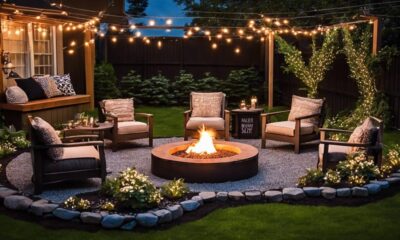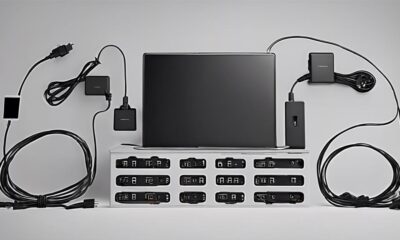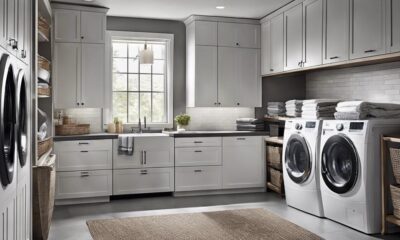Retreat
How to Design a Shipping Container Home
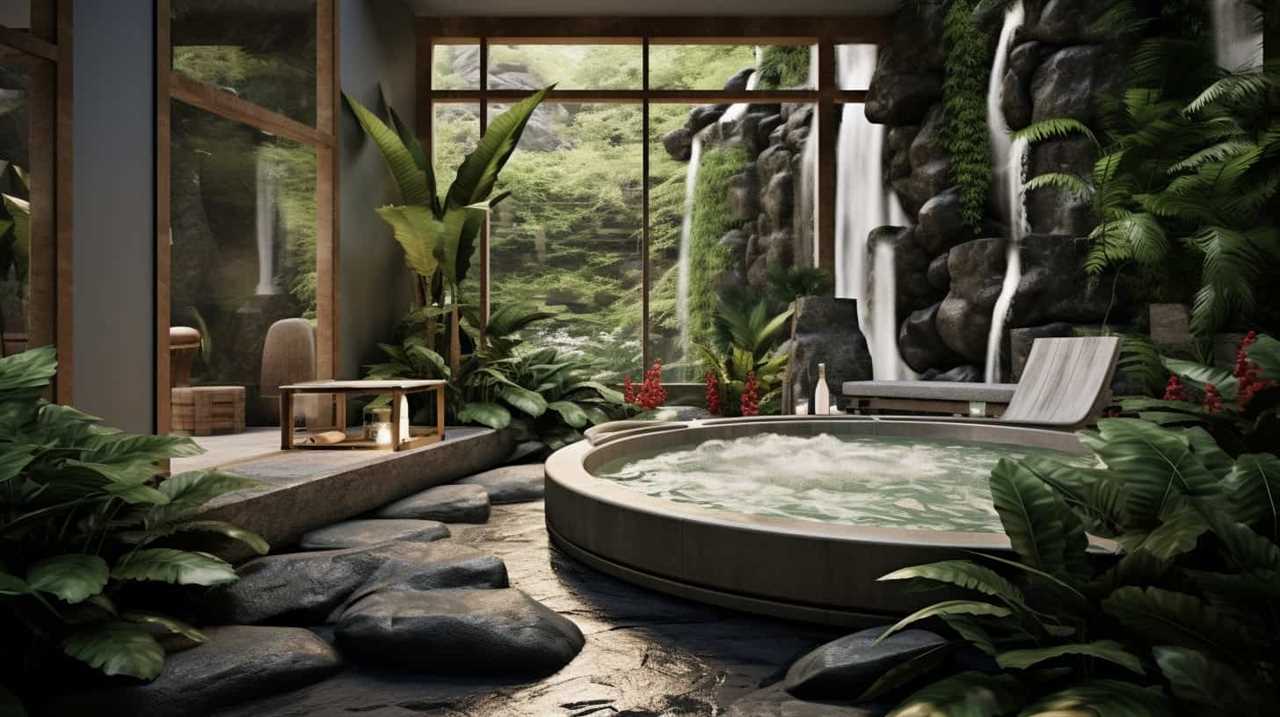
Hey there!
Have you ever dreamed of designing your own home? Well, we’ve got an exciting idea for you – a shipping container home!
In this article, we’re going to show you how to transform these sturdy steel boxes into a cozy and sustainable living space. From selecting the right containers to adding creative interior design elements, we’ll guide you through the entire process.
Get ready to unleash your creativity and build a unique home that’s both practical and stylish!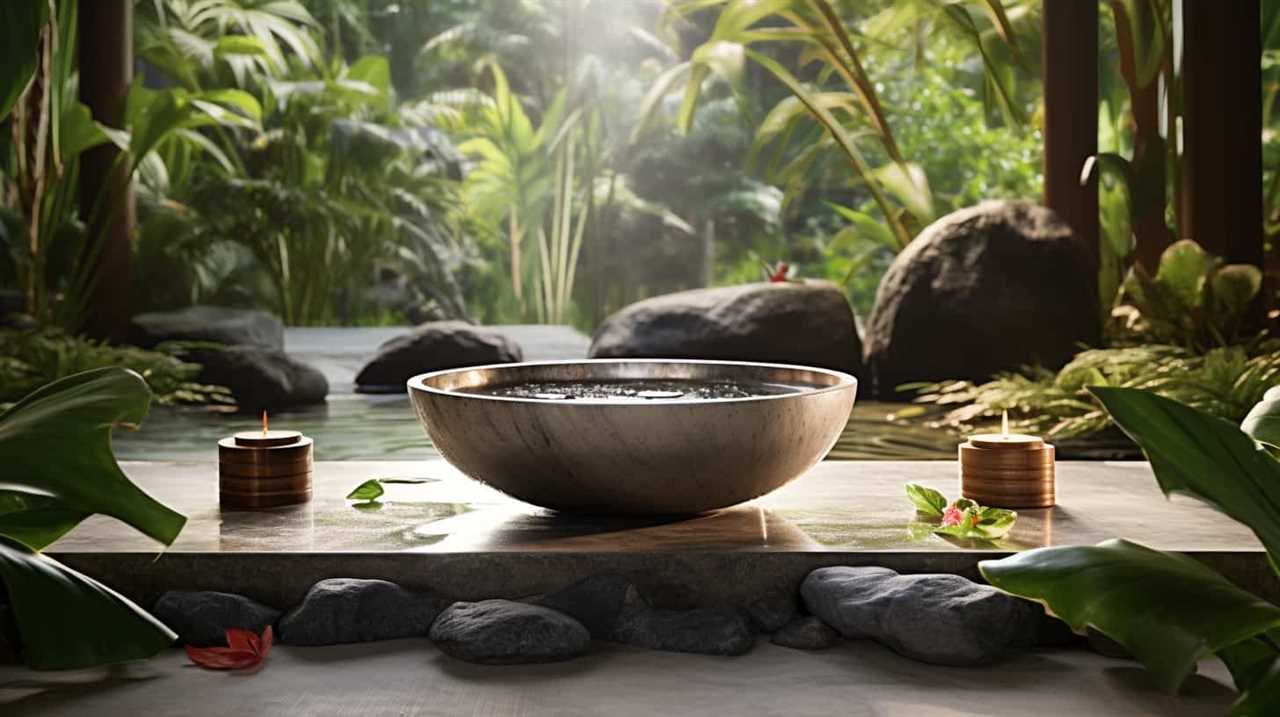
Key Takeaways
- Consider the size and condition of containers, prioritize minimal damage, and evaluate structural integrity when selecting and modifying containers for a shipping container home.
- Carefully plan the layout and floor plan to optimize space, maximize natural light, and promote functionality and openness in the design.
- Incorporate sustainable design features such as eco-friendly materials, energy-efficient appliances, insulation for temperature regulation, and rainwater harvesting systems.
- Ensure structural integrity and safety by considering weight distribution, using a solid and level foundation, performing structural analysis, and utilizing reinforced steel beams and columns.
Selecting the Right Containers
We’ll need to consider the size and condition of the containers before selecting the right ones for our shipping container home. When choosing containers, we should prioritize those with minimal damage, as repairs can be costly and time-consuming.
Insulating containers is an important aspect to ensure comfort and energy efficiency in our new home. Additionally, modifying containers may be necessary to meet our specific design requirements. This could involve cutting windows and doors, reinforcing walls for structural integrity, and adding insulation materials to regulate temperature.
It’s crucial to carefully evaluate the containers’ structural integrity and ensure they’re suitable for the modifications needed. By taking these factors into account, we can select the right containers that will provide a sturdy and well-insulated foundation for our shipping container home.
Planning the Layout and Floor Plan
To ensure an efficient and functional living space, we need to carefully plan out the layout and floor plan of our shipping container home. Space optimization and maximizing natural light are key factors to consider in this process.
By strategically organizing the interior, we can create a comfortable and visually appealing environment. One way to achieve this is by using a 2 column and 5 row table to outline the different areas and their respective dimensions. This helps us visualize the space and determine the best placement for each function.
Additionally, incorporating large windows and skylights allows for ample natural light, creating a bright and inviting atmosphere. By prioritizing space optimization and maximizing natural light, we can create a layout and floor plan that promotes functionality and a sense of openness.
This leads us to the next step: incorporating sustainable design features into our shipping container home.
Incorporating Sustainable Design Features
By incorporating sustainable design features, we can create an environmentally friendly and energy-efficient shipping container home.
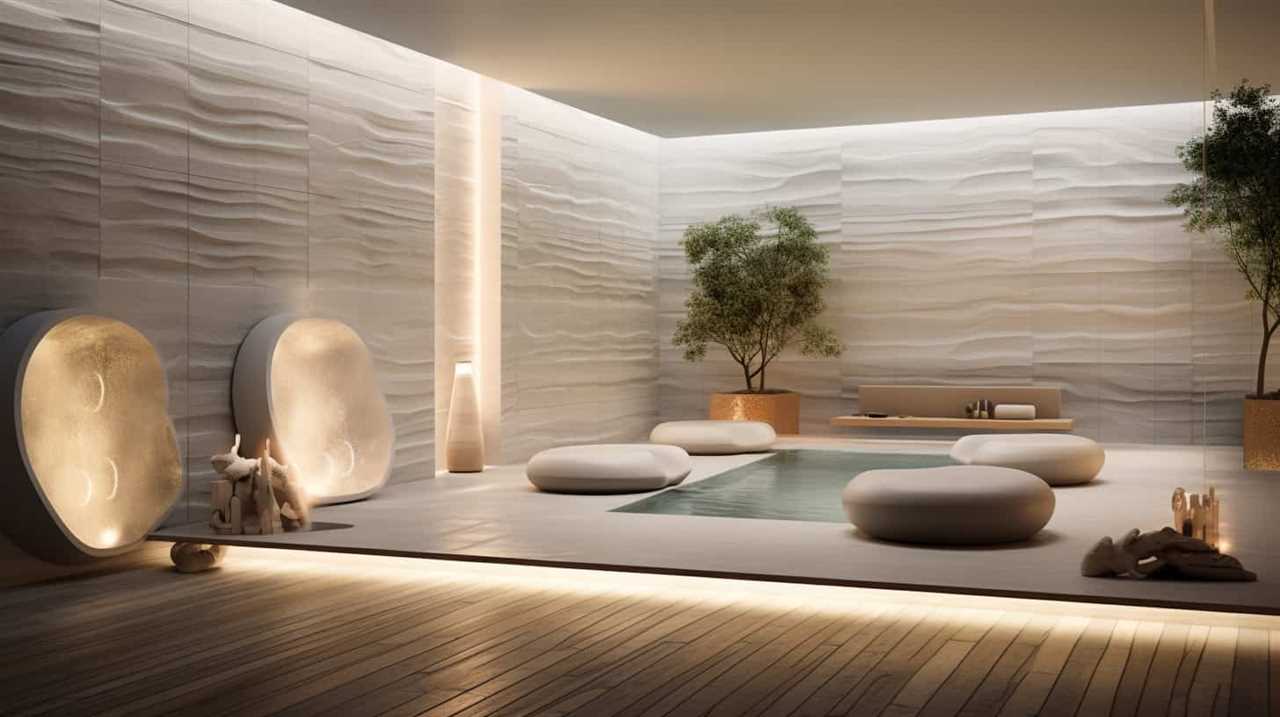
Use eco-friendly materials: Opt for recycled or reclaimed materials for construction, such as bamboo flooring or salvaged wood for furniture. These materials not only reduce waste but also give your home a unique and rustic charm.
Install energy-efficient systems: Choose energy-efficient appliances and lighting fixtures to minimize electricity usage. Consider installing solar panels on the roof to harness renewable energy and reduce reliance on the grid.
Incorporate proper insulation: Insulate the walls, floors, and ceiling of your shipping container home to prevent heat loss in winter and heat gain in summer. This will help maintain a comfortable indoor temperature and reduce the need for excessive heating or cooling.
Implement a rainwater harvesting system: Collect rainwater from the roof and store it in tanks for various household uses. This reduces the consumption of treated water and promotes sustainability.

Ensuring Structural Integrity and Safety
While ensuring structural integrity and safety, we need to carefully consider the weight distribution and foundation of the shipping container home. Structural analysis and construction techniques play a crucial role in ensuring the stability and durability of the structure. To give you a better understanding, let’s take a look at the following table:
| Weight Distribution | Foundation | Structural Analysis | Construction Techniques |
|---|---|---|---|
| Evenly distribute the weight of the containers to avoid excessive stress on certain areas. | Use a solid and level foundation to support the weight of the containers and prevent settling or shifting. | Perform a thorough structural analysis to identify potential weak points and ensure that the design meets safety standards. | Utilize reinforced steel beams and columns to strengthen the structure and distribute the load evenly. |
Adding Creative and Functional Interior Design Elements
As we explore the process of designing a shipping container home, we can incorporate creative and functional interior design elements to enhance the overall aesthetic and functionality of the space. Here are four ways to achieve this:
Unique storage solutions: Maximize the limited space by utilizing clever storage options such as built-in shelves, hidden compartments, and multi-functional furniture. Think vertically and make use of every nook and cranny.
Utilizing natural light: Take advantage of the container’s large windows and open floor plan to let natural light flood in. This not only creates a bright and airy atmosphere but also reduces the need for artificial lighting during the day.
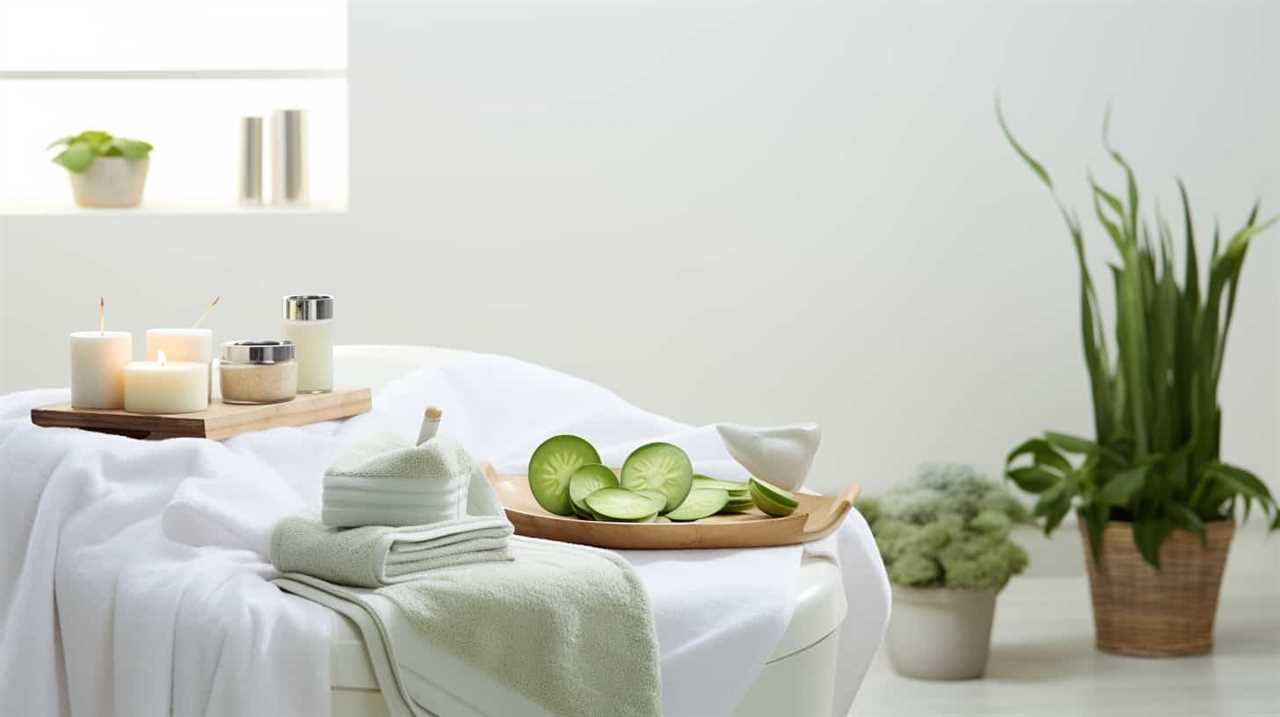
Incorporate multipurpose furniture: Opt for furniture pieces that serve multiple functions, such as a sofa that can also be used as a guest bed or a dining table that can be folded away when not in use. This saves space and adds versatility to your home.
Embrace an open concept: Knock down unnecessary walls and create an open layout that allows for seamless flow between different areas of the container home. This not only makes the space feel larger but also promotes interaction and connectivity.
Frequently Asked Questions
Are There Any Specific Legal Requirements or Permits Needed to Build a Shipping Container Home?
There are specific legal requirements and permits needed to build a shipping container home. It’s important to research and comply with zoning regulations, building codes, and obtain necessary permits before starting the construction process.
How Do I Ensure Proper Insulation and Temperature Control in a Shipping Container Home?
To ensure proper insulation and temperature control in a shipping container home, we’ve found that using insulation techniques such as spray foam or rigid foam boards, along with an energy efficient design, can make a significant difference in maintaining a comfortable living environment.
Can I Add a Second Story or Expand the Size of My Shipping Container Home in the Future?
Yes, you can add a second story or expand the size of your shipping container home in the future. It allows for flexibility and customization, making it an ideal choice for those looking for versatility in their home design.
What Are the Maintenance and Upkeep Requirements for a Shipping Container Home?
Maintenance and upkeep requirements for a shipping container home include regular inspections, cleaning, and sealing to prevent rust and corrosion. Challenges with plumbing and electrical installations, insulation, and temperature control can be overcome with proper planning and expertise. Legal requirements and permits are essential.
Are There Any Limitations or Challenges When It Comes to Plumbing and Electrical Installations in a Shipping Container Home?
Plumbing challenges and electrical installations limitations are important considerations in designing a shipping container home. We must carefully plan and navigate the limited space and structural constraints to ensure proper functionality and safety.
Can a Shipping Container Home Design Influence the Style of a Bucket Hat?
When designing a shipping container home, it’s important to consider how the overall style will complement the surrounding environment. The same goes for a stylish bucket hat tutorial. Both require attention to detail and a cohesive design that reflects the desired aesthetic.
Conclusion
In conclusion, designing a shipping container home requires careful consideration of various factors. These include selecting the right containers, planning the layout, incorporating sustainable design features, ensuring structural integrity, and adding creative interior design elements. By marrying practicality with creativity, one can create a unique and eco-friendly living space. This living space not only meets the functional needs but also reflects their personal style.
So, grab your tools and let your imagination run wild as you embark on the journey of building your very own shipping container home.
- About the Author
- Latest Posts
Introducing Charles, the Editor in Chief at ByRetreat, whose passion for interior design and editorial excellence elevates every remote workspace to new heights. With his keen eye for detail, impeccable taste, and expertise in design, Charles brings a wealth of knowledge and creativity to the ByRetreat team.
As the Editor in Chief of a renowned lifestyle blog, Charles has honed his skills in curating captivating content and staying up-to-date with the latest trends in interior design. His deep understanding of aesthetics and the power of storytelling through design enables him to create remote workspaces that are not only visually stunning but also rich in personality and meaning.
Retreat
DIY Organic Skincare Products for Your Home Spa Experience
Indulge in creating your own organic skincare products for a rejuvenating home spa experience that will leave you craving more pampering ideas.
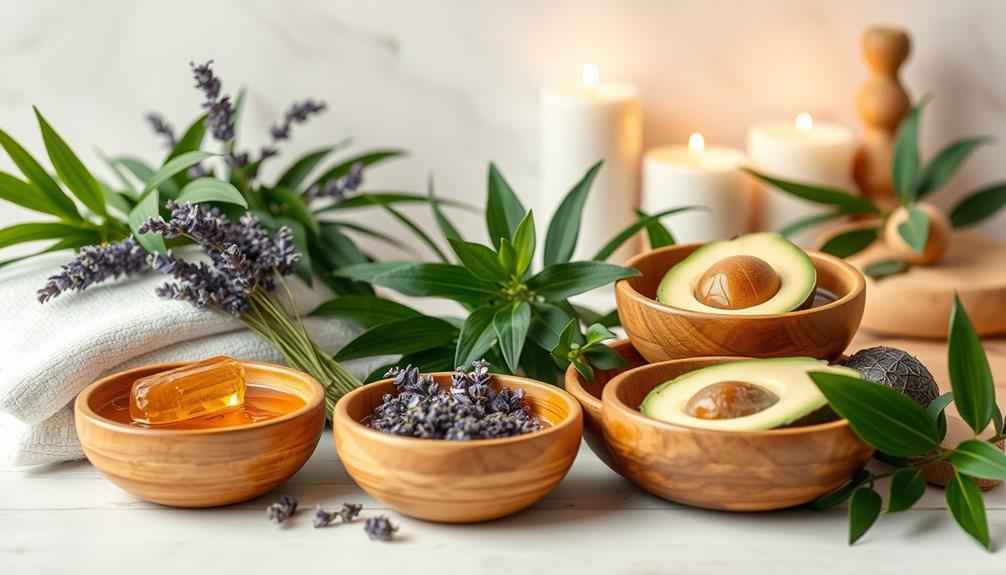
You can easily create your own organic skincare products for a pampering home spa experience. Start by mixing natural ingredients like avocado and aloe vera for hydration or try a detoxifying clay mask. Enhance relaxation by incorporating essential oils like lavender, and light some non-toxic candles to set the mood. Don't forget to play calming music and sip herbal tea for added comfort. To make your spa experience even more special, consider crafting a personalized gift basket of your creations. Keep exploring to discover more DIY recipes and tips for your perfect home spa setup!
Key Takeaways
- Create nourishing face masks using natural ingredients like avocado, banana, and honey for hydration and skin benefits.
- Incorporate clay and coffee grounds into DIY scrubs and masks for detoxifying and exfoliating properties.
- Use essential oils like lavender or chamomile to enhance relaxation and promote a soothing atmosphere.
- Prepare warm herbal teas or natural wine to complement your spa rituals and enhance comfort.
- Utilize non-toxic scented candles to create a calming environment and elevate your home spa experience.
Creating a Relaxing Atmosphere
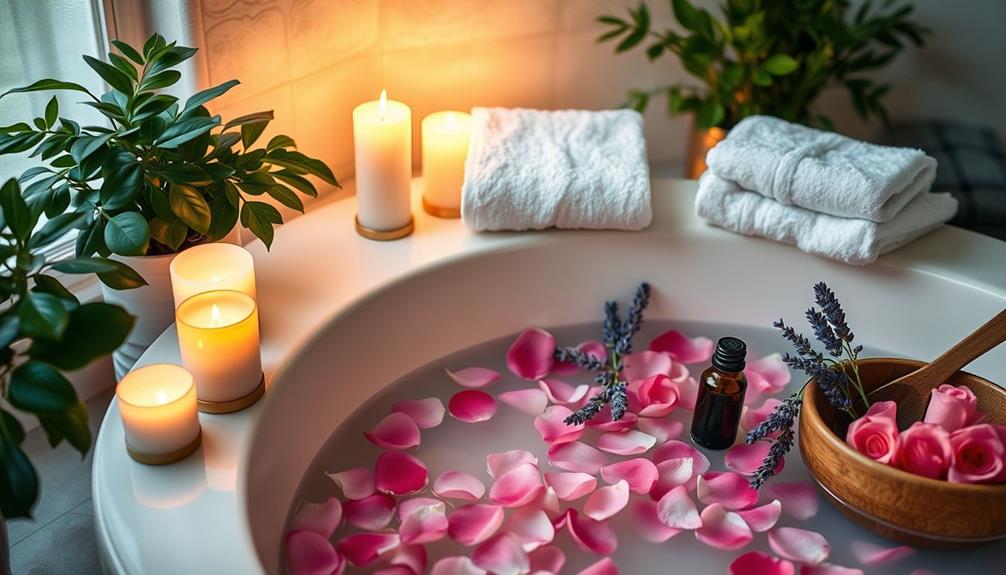
Creating a relaxing atmosphere is essential for a successful home spa experience. Start by incorporating non-toxic scented candles; their soft glow and calming scents can greatly enhance your relaxation.
Choose scents like lavender or chamomile, as these essential oils are known for their soothing properties and ability to improve your mood. You might also consider using essential oils for relaxation such as eucalyptus or peppermint, which can further enhance the calming environment.
Next, play calming music playlists that can reduce stress and make your DIY skincare session more enjoyable. The right tunes can transport you to a serene environment, easing your mind and allowing you to focus on pampering your skin.
You might also consider offering warm beverages, such as herbal tea or natural wine. Sipping on a comforting drink helps soothe both your mind and body, contributing to a tranquil atmosphere.
Key Ingredients for Spa Treatments
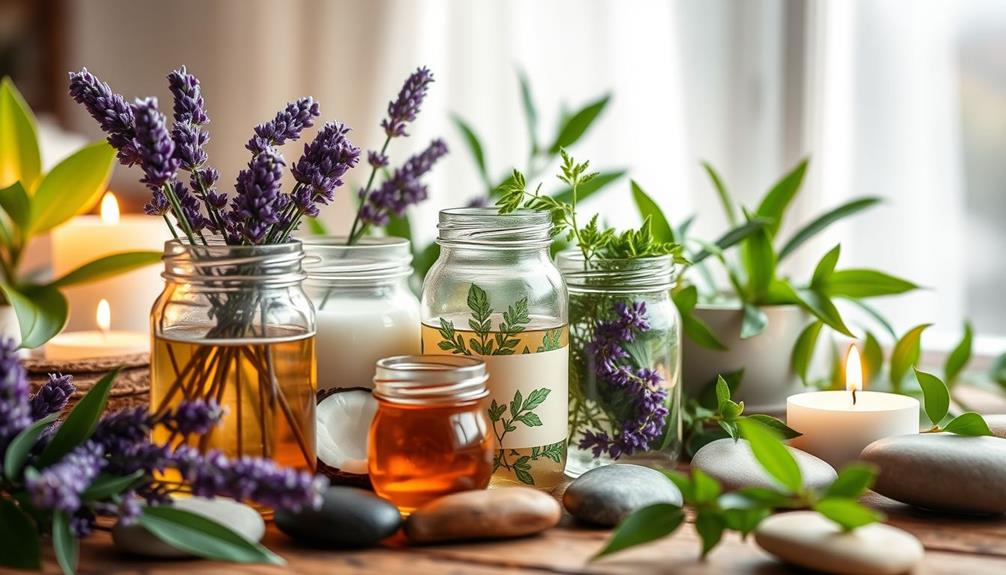
When it comes to spa treatments at home, you can't go wrong with natural food ingredients like avocado and banana for their nourishing benefits.
Incorporating coffee's unique flavor profiles can also enhance your DIY skincare routine, as coffee grounds can be used as an exfoliant to rejuvenate the skin.
Also, consider using dry ingredients like clay, which are perfect for creating shelf-stable products that detoxify your skin without needing water.
Natural Food Ingredients
Natural food ingredients are fantastic for enhancing your DIY spa treatments, offering a wealth of benefits for your skin. Ingredients like avocado and banana are powerhouses of vitamins and essential fatty acids, making them excellent choices for moisturizing and nourishing skin. You can easily incorporate these into your DIY recipes for homemade skincare products that truly pamper you.
Additionally, ingredients like aloe vera can provide soothing properties, making it a great addition for calming irritated skin potential side effects include gastrointestinal issues.
Another great option is clay, which works wonders in masks by absorbing excess oil and impurities. It promotes clearer skin without the need for water, allowing you to create effective natural skincare products that last longer.
Remember, avoiding water in your formulations can help prevent bacterial growth, extending the shelf life of your creations.
To guarantee maximum efficacy, proper mixing of ingredients is essential. When you blend your ingredients well, you not only enhance the effectiveness but also improve the overall experience of applying your products.
For added shelf stability, consider including natural preservatives like vitamin E or botanical extracts. These steps will help keep your DIY spa treatments fresh and effective, so you can enjoy nourishing, moisturizing benefits whenever you indulge in your home spa experience.
Shelf-Stable Product Considerations
Shelf-stable spa treatments require careful selection of ingredients to confirm they remain effective over time. When crafting your DIY skincare recipes, opt for dry ingredients like clay, which are naturally shelf-stable and eliminate the need for preservatives. These components not only provide effective skin treatment but also guarantee your products last longer without refrigeration.
Additionally, understanding the importance of selecting the right cold medication can be beneficial, as the knowledge of effective, safe ingredients can translate into your skincare formulations.
Natural food ingredients, like avocado and banana, offer nourishment but typically require refrigeration to maintain their freshness. If you choose to incorporate these, be aware that they'll reduce your product's shelf life. To counter this, consider adding preservatives to your formulations. These help maintain the quality and effectiveness of your DIY spa products, making them safer for long-term use.
It's vital to avoid using water in your skincare recipes, as this can promote microbial growth, leading to spoilage. Clear mixing instructions will also enhance the user experience, confirming that anyone can create effective, safe spa treatments at home.
Essential Items for Home Spa Set
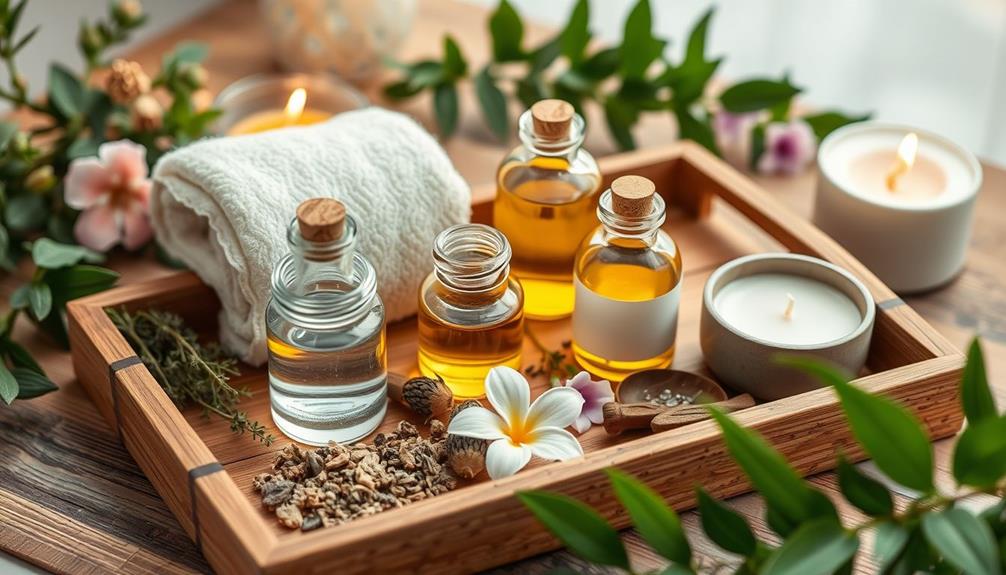
To create the perfect home spa set, it's vital to include a variety of homemade skincare products tailored to your skin type, such as cleansers, masks, and moisturizers made from organic ingredients.
By using natural skincare products, you're not only enhancing your skin health but also enjoying a fulfilling spa experience in the comfort of your home. Incorporating ingredients like glycolic acid can be beneficial, as it aids in exfoliation and promotes skin clarity, making it a great addition to your homemade skincare routine Glycolic acid for skin benefits.
Here are some essential items to keep in mind for your home spa set:
- Cleansers: Choose gentle, organic cleansers that suit your skin type.
- Face Masks: Incorporate nourishing face masks with ingredients like honey or avocado to hydrate your skin.
- Essential Oils: Add oils like lavender or eucalyptus for mood enhancement and aromatherapy benefits.
- Scented Candles: Use non-toxic scented candles to create a calming atmosphere during your treatments.
Don't forget to include a buckwheat eye mask for soothing pressure and comfort, and think about an exfoliating dry brush to promote skin rejuvenation.
Together, these elements will elevate your home spa experience, transforming your routine into a rejuvenating ritual. Enjoy your personalized oasis!
Spa Gift Basket Selection
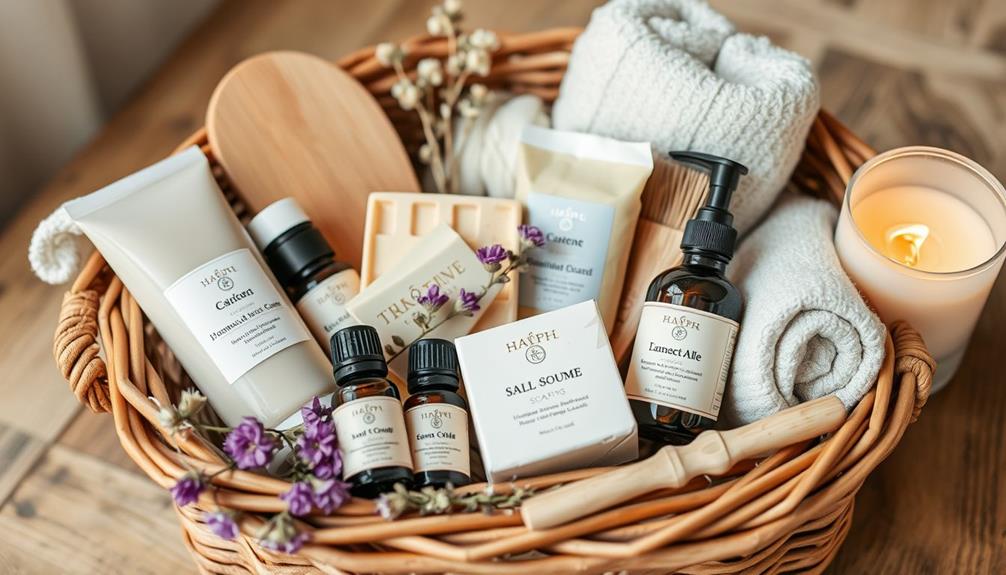
When you're putting together a spa gift basket, choosing the right basket is key to making a lasting impression.
Consider adding some homemade infused oils or natural scrubs that incorporate juice extracts for health benefits.
Think about aesthetic packaging options that reflect a calming vibe, and don't forget to personalize it with labels for each product.
This thoughtful touch not only enhances the gift but also makes it easy for the recipient to enjoy their self-care experience.
Choosing the Right Basket
Choosing the right basket for your spa gift basket can make all the difference in creating a thoughtful and inviting presentation. A functional basket not only holds your skincare products but also contributes to the overall aesthetic of your gift.
When selecting your basket, consider these important factors:
- Material: Go for woven fibers, metal, or sturdy bins for durability and visual appeal. The choice of material can also reflect the natural elements of your DIY organic skincare products, promoting a sense of well-being and connection to nature, as emphasized in key domains of development in psychology.
- Organization: Include jars or containers for DIY treatments, making it easy to access various products.
- Aesthetic: Opt for aesthetically pleasing packaging that complements the theme of relaxation and self-care.
- Repurposing: Confirm items in the basket are easy to repurpose or regift, extending their usefulness beyond the spa experience.
To personalize the gift, add labels for each product, offering helpful instructions or descriptions. This thoughtful touch enhances the user's experience and makes your spa gift basket truly memorable.
Aesthetic Packaging Options
Aesthetic packaging options play an essential role in elevating your spa gift basket, making it visually appealing while enhancing the overall experience.
Start by selecting a functional basket made from materials like woven fibers or metal, which aligns beautifully with the modern farmhouse decor trends that emphasize natural materials. This choice not only serves as storage and decoration for your spa gifts but also adds a rustic charm.
Next, incorporate jars or containers for your DIY treatments. These not only keep the products organized but also provide a personalized touch that shows you care. Choose colors and designs that evoke calm and relaxation, which will further enhance the overall spa experience for the recipient.
Consider labeling each product clearly, offering instructions or highlighting benefits. This added detail not only makes it easier for the user but also enriches their experience with your thoughtfully curated gifts.
Lastly, make certain that your items are easy to repurpose or regift, allowing your recipient to enjoy the packaging long after the products are gone.
Personalization Ideas for Gifts
Personalizing your spa gift basket adds a unique touch that shows you truly care about the recipient's preferences and needs. Consider the following ideas to make your basket special:
- Select a functional basket: Choose one made from woven fibers or metal that's both practical and visually pleasing.
- Include DIY jars: Add containers for homemade skincare recipes, allowing them to recreate their favorite natural skincare products. You might also consider incorporating safe snacks for hamsters as a fun and whimsical touch if the recipient is a pet lover.
- Label each item: Personalize the basket by clearly labeling products with their names and purposes, enhancing the recipient's experience.
- Cater to skin types: Make sure you include a variety of products, like scented candles or essential oils, that cater to different skin types and preferences.
Assembling the Spa Kit
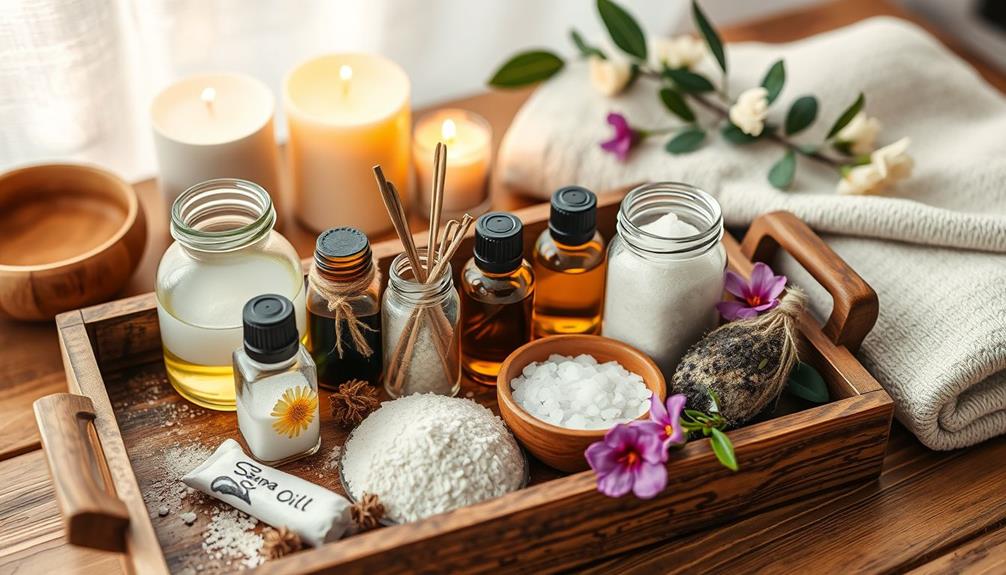
Creating a spa kit is all about combining essential elements that cater to your unique self-care needs. Start by gathering a mix of bulk items like soaks and scrubs, along with smaller, specialized natural skincare products.
Incorporating relaxing elements, such as unique planter designs, can also enhance the overall ambiance of your spa experience. This combination guarantees you have everything necessary for effective spa treatments. Organize your kit by body area—face, hands, and feet—for easy access while you pamper yourself.
Don't forget to include relaxing beverages like natural wine or herbal tea to enhance your experience and promote relaxation. They'll pair beautifully with your spa rituals.
To create a calming atmosphere, add beeswax candles; their soft glow and gentle fragrance can greatly elevate your self-care environment.
DIY Skin Spa Recipes and Masks
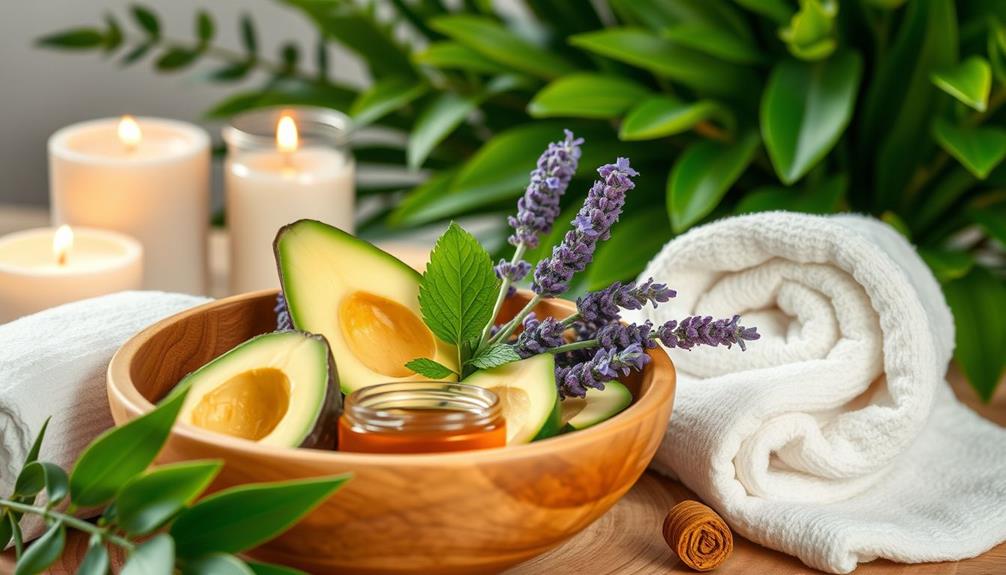
When you want to indulge in a rejuvenating spa experience at home, DIY skin spa recipes and masks are your best bet.
These natural skincare recipes harness the power of ingredients like oatmeal, honey, and avocado to nourish and soothe your skin. Here are some fantastic options to try:
- Revitalizing Cocoa Mask: Combine cocoa and yogurt for an anti-aging treatment that hydrates and gently exfoliates.
- Exfoliating Soda Soak: Use baking soda for a quick foot treatment that smooths rough skin on your feet, knees, and elbows.
- Cucumber Eye Masks: Place cold cucumber slices over your eyes to soothe and depuff tired eyes.
- Enzyme-Rich Papaya Masks: Mix papaya with egg whites and yogurt for a mask that hydrates and tightens skin.
Don't forget to add a few drops of your favorite essential oil to any mask for an extra touch of luxury!
These DIY skin spa recipes will leave you feeling refreshed and looking radiant with glowing skin. Immerse yourself in these simple yet effective masks to elevate your home spa experience.
Frequently Asked Questions
How Do I Create a Spa Like Experience at Home?
To create a spa-like experience at home, light non-toxic candles, play calming music, and use essential oils. Offer herbal tea, keep your space tidy, and add cozy touches like an eye mask for ultimate relaxation.
How Can I Make Organic Skin Care at Home?
To make organic skincare at home, identify your skin type, choose natural ingredients, and mix simple recipes like banana masks or almond oil blends. Experiment with essential oils and store products properly for freshness. Enjoy!
How Do You Give Yourself a Spa Treatment at Home?
To give yourself a spa treatment at home, you'll want to create a calming atmosphere, gather relaxing essentials, prepare soothing treatments, and set aside time for self-care. Don't forget your favorite beverage for added enjoyment!
What Skin Care Can I Make at Home?
You can make various skincare products at home using ingredients like avocado for masks, honey for cleansers, and oatmeal for exfoliation. Customize them based on your skin type for the best results and nourishment.
Conclusion
Incorporating DIY organic skincare into your home spa experience not only nourishes your skin but also rejuvenates your spirit. Remember, "self-care isn't selfish." By creating a relaxing atmosphere and using key ingredients, you can elevate your pampering sessions. With your essential items and thoughtfully assembled spa kit, you're well-equipped to indulge in luxurious treatments. So go ahead, treat yourself to some well-deserved relaxation and let your inner glow shine through!
- About the Author
- Latest Posts
Introducing Ron, the home decor aficionado at ByRetreat, whose passion for creating beautiful and inviting spaces is at the heart of his work. With his deep knowledge of home decor and his innate sense of style, Ron brings a wealth of expertise and a keen eye for detail to the ByRetreat team.
Ron’s love for home decor goes beyond aesthetics; he understands that our surroundings play a significant role in our overall well-being and productivity. With this in mind, Ron is dedicated to transforming remote workspaces into havens of comfort, functionality, and beauty.
Retreat
Incorporating Water Features in Your Retreat Center Design
Incorporating water features in your retreat center design can transform the atmosphere, but what essential elements should you consider for the best impact?
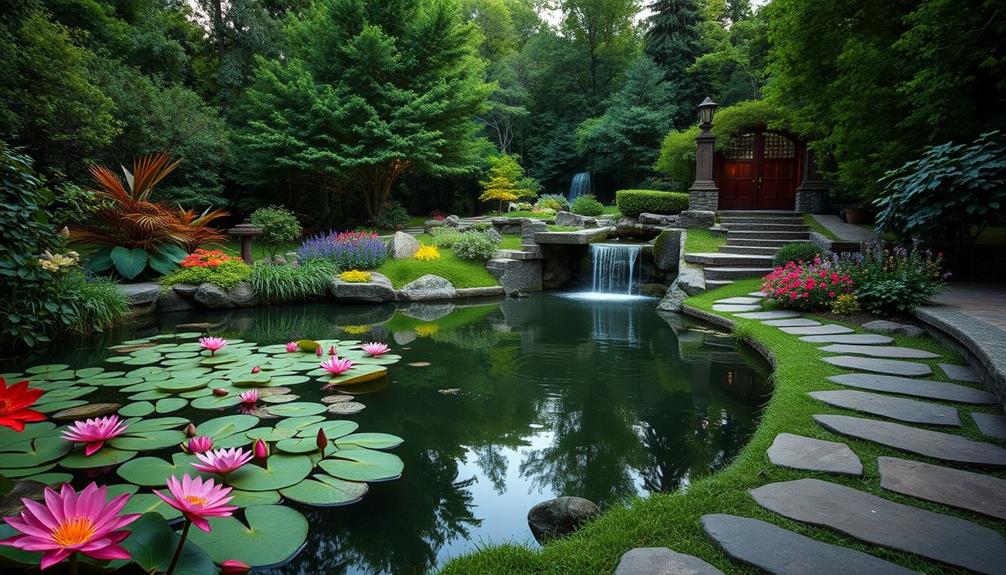
Incorporating water features in your retreat center design creates a serene environment that fosters relaxation and enhances the overall experience. Elements like flowing streams and reflective ponds not only add beauty but also promote well-being by reducing stress and encouraging mindfulness. Surround these features with lush greenery to support biodiversity and create inviting spaces for guests to unwind. Make certain your designs align with the center's theme and are eco-friendly for minimal maintenance. Thoughtful integration of water features can elevate your retreat's ambiance, making it truly unforgettable. Discover how to perfect these elements for maximum impact and guest satisfaction.
Key Takeaways
- Choose diverse water features like flowing streams and reflective ponds to enhance aesthetics and promote relaxation in your retreat center design.
- Integrate natural elements such as plants and stones around water features to foster tranquility and support local biodiversity.
- Ensure water features are low-maintenance and eco-friendly to minimize upkeep while maintaining serenity and sustainability.
- Position water features as focal points to encourage social interaction and exploration among guests in outdoor spaces.
- Align the design of water features with the overall theme of the retreat, enhancing guest experiences and promoting well-being.
Benefits of Water Features

When you incorporate water features into your retreat center design, you really elevate the overall experience for your guests. These elements bring beauty and tranquility, transforming your landscape design into a serene oasis. Striking visual focal points, like flowing fountains or cascading waterfalls, can be customized to match your center's theme, enhancing its aesthetic appeal.
Additionally, creating a calming atmosphere can be particularly beneficial for seniors, who may experience heightened stress levels; incorporating these features can promote relaxation and well-being, similar to managing behavioral issues in seniors.
The soothing sound of flowing water plays an essential role in promoting relaxation. Guests often find that the gentle murmur helps reduce stress and anxiety, creating a peaceful environment ideal for rejuvenation.
Additionally, water features contribute to local biodiversity by offering habitats for wildlife, such as birds and butterflies, which enrich the ecological value of your grounds.
Moreover, well-designed water features can help regulate temperature in outdoor spaces, making them more inviting year-round. This comfort can lead to increased guest satisfaction, encouraging repeat visits and boosting your retreat center's marketability.
Not only do water features enhance the ambiance, but they can also increase property value, making your center more attractive to potential clients in a competitive landscape. Embracing these benefits truly transforms your retreat into a sought-after destination.
Types of Water Features
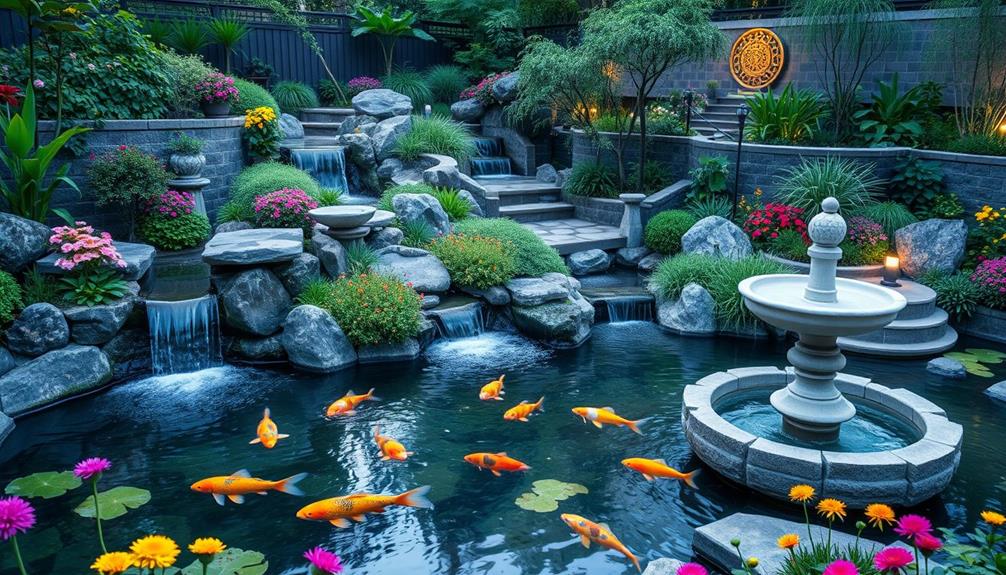
When considering types of water features for your retreat center, think about how flowing streams can transform larger spaces with their natural movement and soothing sounds.
These features can also attract local wildlife, enhancing the connection to nature and providing opportunities for wildlife observation.
Reflective ponds also offer a unique appeal, creating peaceful spots for meditation and quiet contemplation.
Each feature not only enhances the landscape but also contributes to the overall tranquility of the environment.
Flowing Streams Benefits
Incorporating flowing streams into retreat center design not only enhances the aesthetic appeal but also creates a soothing atmosphere that promotes relaxation. The gentle sound of flowing water contributes to a peaceful environment, allowing guests to unwind and rejuvenate.
Research shows that the presence of water can greatly reduce stress, making it an essential feature for any wellness-focused retreat. Additionally, the calming effects of natural elements, including water features, can be compared to the benefits of cold medications overview that alleviate discomfort and enhance well-being during stressful times.
Flowing streams can also break up large spaces, adding visual interest and guiding movement throughout the area. By strategically placing these water features, you can create a natural flow that encourages exploration and connection with nature.
Additionally, flowing streams support biodiversity by providing habitats for various wildlife, attracting birds and insects that enrich the overall experience for your guests.
Customization is another advantage of incorporating flowing streams. You can tailor the width, depth, and surrounding vegetation to harmonize with the natural landscape, ensuring that the design feels cohesive.
Whether you envision a meandering stream or a more structured waterway, these elements can transform your retreat center into a truly serene sanctuary, enhancing both its beauty and the well-being of those who visit.
Reflective Ponds Appeal
Reflective ponds offer their own unique appeal, complementing the soothing qualities of flowing streams. These serene environments encourage contemplation and relaxation, making them ideal for retreat centers focused on well-being and mindfulness.
The beauty of reflective ponds lies not only in their visual allure but also in their ecological benefits, much like the way DIY Fire Pit Ideas can enhance outdoor spaces with inviting designs.
Here are four key reasons to incorporate reflective ponds into your design:
- Calming Atmosphere: The tranquil surfaces of reflective ponds create a peaceful setting, perfect for meditation or quiet reflection.
- Biodiversity Enhancement: By serving as habitats for fish, birds, and other wildlife, these ponds promote a vibrant ecosystem within your retreat's landscape.
- Visual Expansion: Reflective ponds can visually expand outdoor spaces, serving as a stunning focal point for gatherings and events.
- Biophilic Design: Incorporating lush greenery and natural materials around the ponds fosters a stronger connection between occupants and nature.
To guarantee the longevity and enjoyment of these calming features, regular maintenance is essential. Keeping the water clear and healthy enhances the overall experience, allowing you and your guests to fully appreciate the tranquility that reflective ponds provide.
Integrating Natural Elements
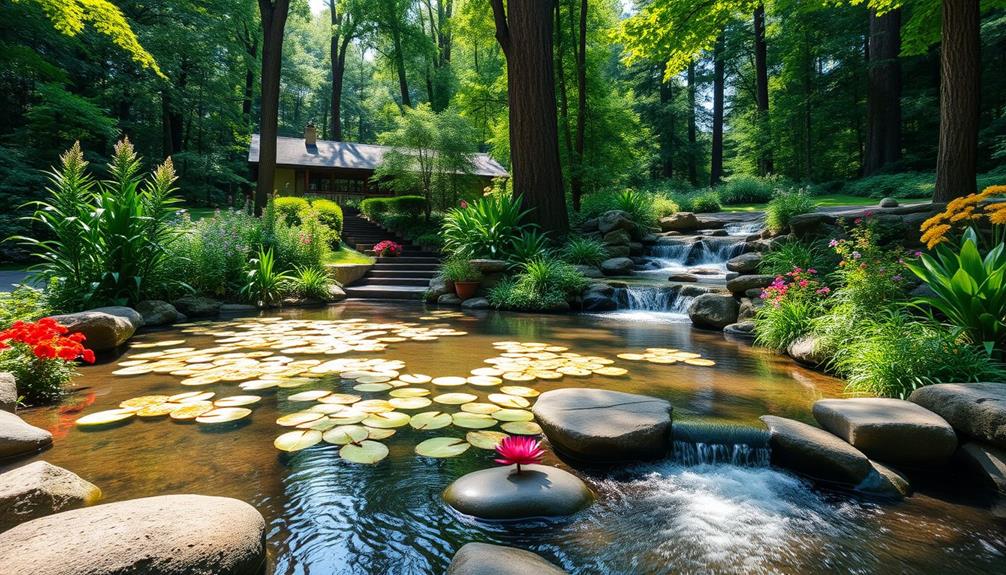
When you integrate natural elements like plants and stones around your water features, you not only enhance the aesthetic appeal but also promote biodiversity.
This connection to nature invites a sense of tranquility, making it easier for guests to unwind.
Enhancing Aesthetic Appeal
Throughout the design of a retreat center, integrating natural elements like plants and rocks around water features considerably enhances aesthetic appeal.
Elements such as a well-draining soil mix can support lush greenery, which is crucial for creating a tranquil outdoor space. This seamless connection between water and its surroundings is essential for promoting relaxation for your visitors.
By incorporating these elements, you can elevate the beauty and best soil for String of Hearts plants and promote a serene atmosphere. Here are some effective strategies:
- Lush Greenery: Surround reflective ponds with vibrant plants to amplify the calming effects of water and beautify the landscape.
- Natural Stone: Use materials like natural stone for pathways or seating areas, adding texture while harmonizing with the environment.
- Focal Points: Position water features strategically to create eye-catching focal points that encourage exploration of the outdoor areas.
- Diverse Features: Incorporate various water elements, such as wall-mounted waterfalls or tranquil ponds, to reflect the center's identity and enhance guest experiences.
Promoting Biodiversity Benefits
Integrating water features into your retreat center design not only creates a visually appealing landscape but also promotes biodiversity. By including elements like ponds and reflective pools, you can attract a variety of wildlife, such as birds and butterflies, which enhances biodiversity and supports local ecosystem health.
These water features provide essential habitats for aquatic life, fostering ecological diversity that benefits both the environment and your guests' experiences. Implementing energy-efficient systems, like the best heat pumps, can further enhance the sustainability of your retreat center.
The presence of water supports natural pollination and pest control, helping to maintain a balanced ecosystem. Strategically placing these features amidst lush greenery creates serene environments that encourage relaxation while nurturing a healthy ecosystem.
You'll also find that utilizing natural materials, like rocks and native plants around your water features, amplifies your connection to the surrounding landscape.
This integration not only beautifies your retreat center but also guarantees it contributes positively to the local ecosystem. By promoting biodiversity, you're creating a space where guests can truly connect with nature, enhancing their retreat experience while supporting ecological sustainability.
Enhancing Sensory Experiences
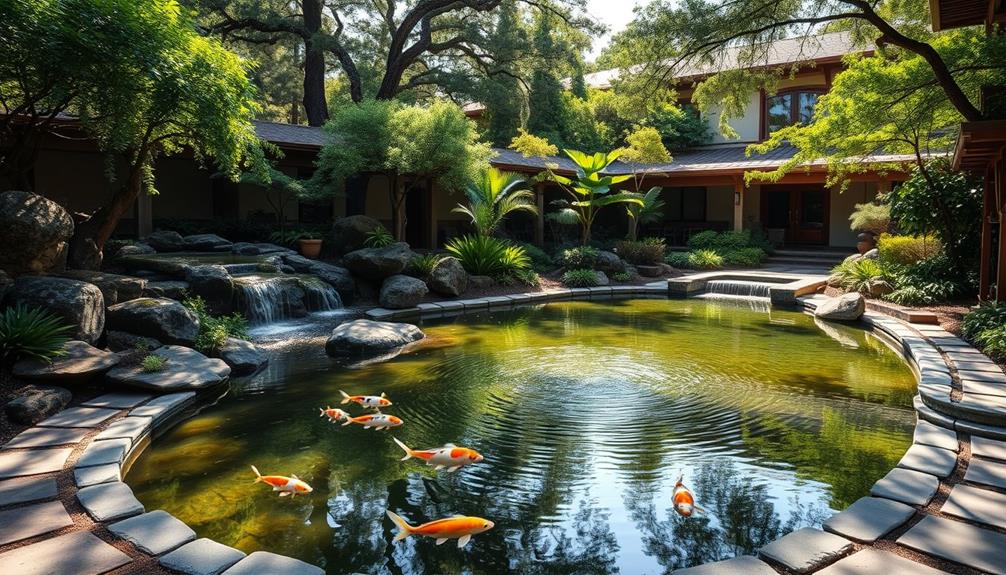
Water features play an essential role in enhancing sensory experiences at retreat centers. The sound of flowing water from fountains and waterfalls creates a calming ambiance that helps reduce stress and promote relaxation.
By incorporating water features, you engage multiple senses, inviting guests to experience a serene environment. Additionally, well-structured content that highlights the benefits of these features can boost credibility and trustworthiness, ultimately enhancing the overall guest experience and engagement metrics, as seen in holistic SEO approaches.
Here are four ways water features enhance sensory experiences:
- Sound: The soothing sounds of water create a tranquil atmosphere, perfect for meditation and mindfulness practices.
- Visual Movement: Gentle ripples and cascading flows offer a dynamic visual element, promoting a sense of peace.
- Tactile Experiences: Guests can engage with water through reflection ponds or interactive features, encouraging a deeper connection with nature.
- Wildlife Attraction: Water features can draw in birds and other wildlife, adding visual interest and enriching the overall experience.
Design Considerations

When planning a water feature for a retreat center, thoughtful design considerations are vital for guaranteeing it enhances the overall experience. Start by evaluating the scale and proportion of your water feature. An oversized installation can overwhelm a small space, while a tiny one might go unnoticed.
Achieving harmony with the existing architectural elements is important, so choose a style that complements the retreat center's theme. Incorporating natural materials can further enhance the aesthetic, creating a seamless blend with the environment, much like the eco-friendly aspects found in wood pellet fireplaces.
Don't forget about maintenance requirements. Opting for low-maintenance designs allows you to create a serene environment without the burden of extensive upkeep. Familiarize yourself with local regulations, as some areas may impose specific guidelines or permit needs for water features.
Accessibility is another key factor in your design considerations. Guarantee the water feature is easily visible and accessible to all guests, encouraging interaction and engagement with the natural elements.
Maintenance Best Practices
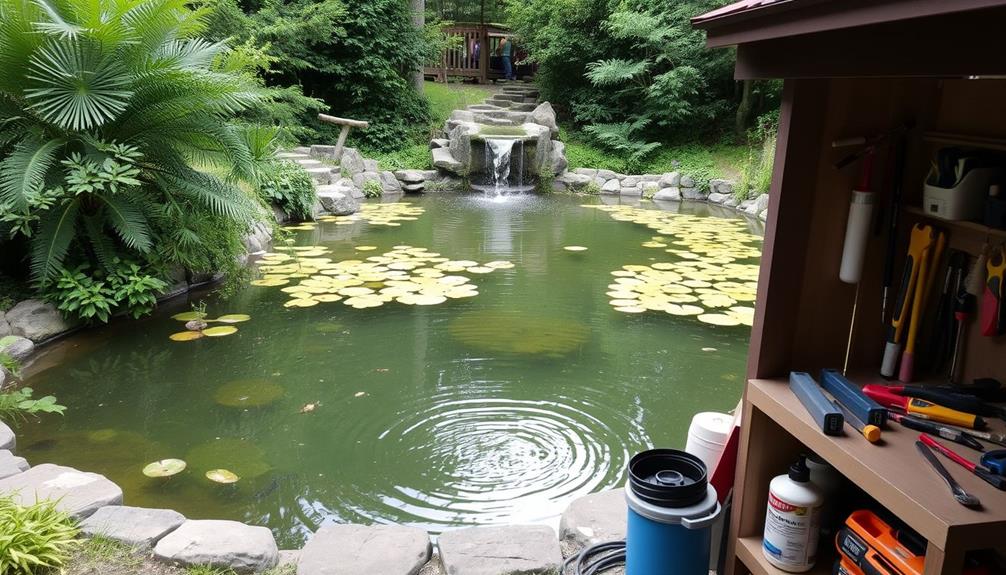
To guarantee your water feature remains a stunning focal point, regular maintenance is key. By following these best practices, you can ascertain its longevity and beauty while creating a healthy environment for wildlife.
Additionally, incorporating elements like hydrotherapy techniques can enhance the overall ambiance and therapeutic benefits of your retreat center.
- Implement a Maintenance Log: Track cleaning schedules, water quality tests, and equipment checks. This log helps you maintain a consistent upkeep routine and spot potential issues before they escalate.
- Conduct Routine Checks: Regularly inspect pumps and lighting systems for proper installation and functionality. This prevents disruptions in water flow or illumination that can detract from the visual appeal.
- Address Algae Growth Promptly: Keep an eye on algae development. Excessive growth can lead to murky water and an unhealthy habitat for aquatic life, so tackle it as soon as you notice it.
- Schedule Cleaning: Regularly remove debris and sediment from your water feature. This not only enhances its aesthetic but also contributes to its overall health and functionality.
Creating Spaces for Relaxation
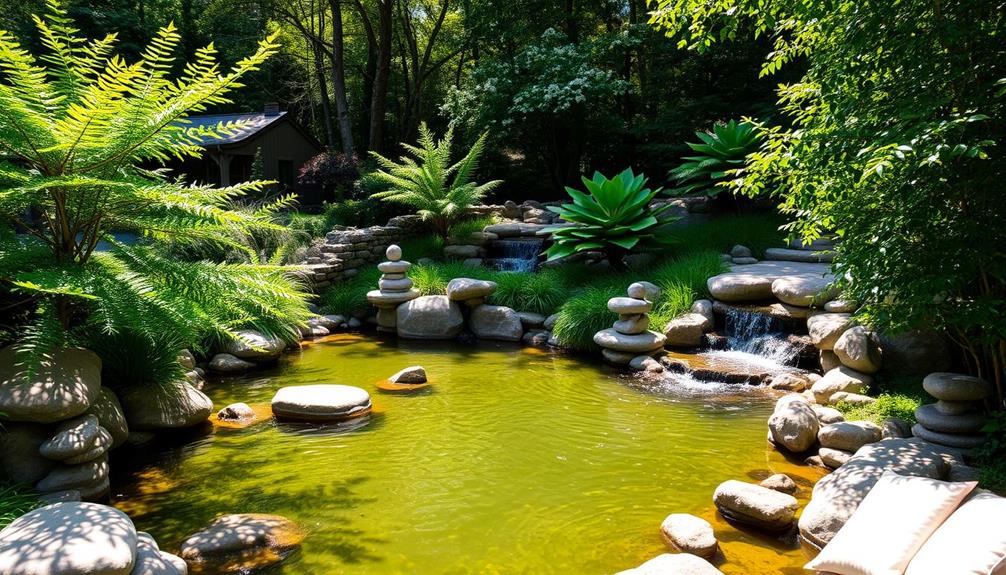
Creating a serene environment with water features can greatly enhance relaxation in a retreat center. By incorporating water features like tranquil ponds and cascading fountains, you create a peaceful atmosphere that invites guests to unwind. The soothing sounds of flowing water not only mask noise but also reduce stress and anxiety, making it ideal for your relaxation-focused space.
Additionally, the use of sustainable energy solutions, such as solar power applications, can further complement the natural ambiance and promote an eco-friendly retreat experience.
Consider integrating reflective ponds surrounded by lush greenery. This natural setting encourages meditation and introspection, allowing guests to connect with nature. The presence of water features also attracts wildlife, such as birds and butterflies, enriching the sensory experience and deepening this connection.
Thoughtfully designed water elements can transform outdoor areas into peaceful oases where visitors feel rejuvenated. Whether it's a small fountain or a larger pond, these features provide calming visuals and sounds that promote overall well-being.
Incorporating water features into your retreat center design isn't just about aesthetics; it's about creating spaces that nurture relaxation and foster a tranquil environment. By prioritizing these elements, you can guarantee that your guests leave feeling refreshed and renewed.
Boosting Aesthetic Appeal
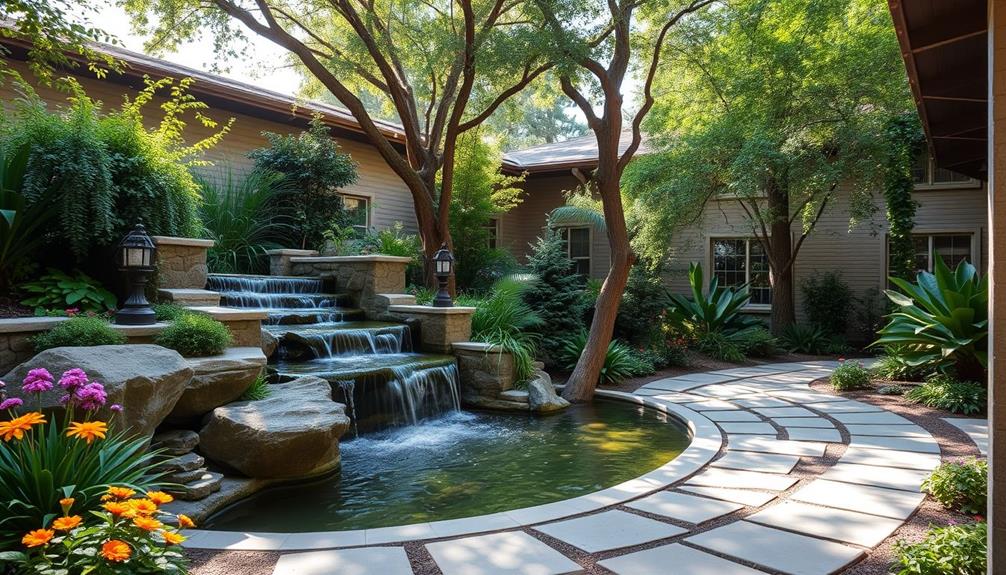
Enhancing the aesthetic appeal of a retreat center often starts with the strategic incorporation of water features.
These elements, like fountains and reflective ponds, not only provide visual allure but also create memorable experiences for your guests.
Here's how you can effectively use water features to boost your center's aesthetic:
- Create Focal Points: Position water features in key areas to draw attention and encourage exploration. A well-placed fountain can become a gathering spot for guests.
- Complement Architectural Styles: Choose designs that align with your retreat's architecture. Options range from modern cascades to naturalistic ponds, ensuring a cohesive look.
- Enhance with Natural Elements: Surround your water features with lush vegetation and natural materials. This blend fosters a tranquil ambiance that resonates with the retreat's purpose.
- Customize for Impact: Utilize lighting and water movement to create unique displays. Customized features can elevate your overall landscape design, making your retreat memorable and enticing repeat visits.
Engaging Guests With Nature
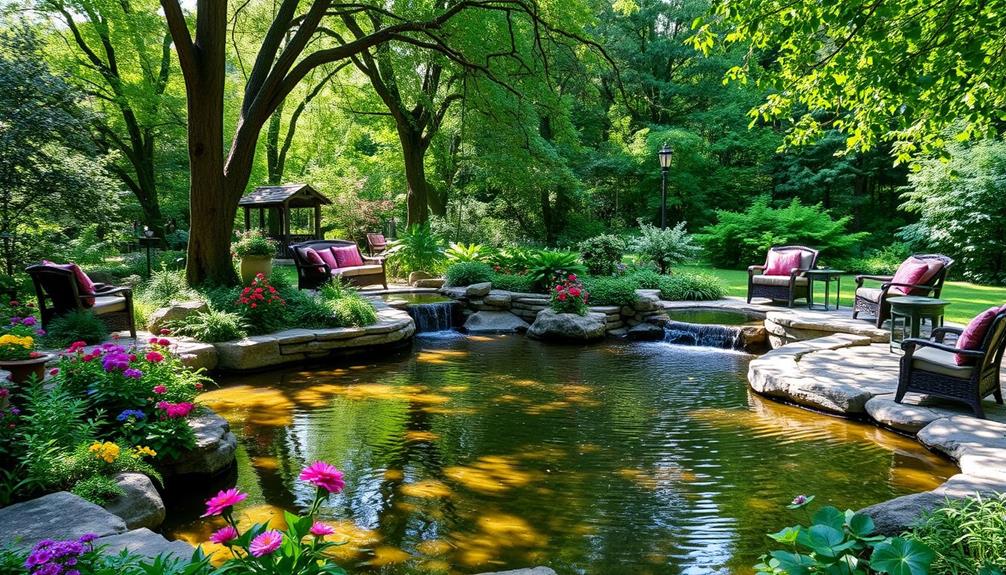
Engaging guests with nature transforms their retreat experience into a journey of discovery and relaxation. By integrating water features like tranquil ponds and cascading fountains, you create a soothing atmosphere that enhances the sensory experience. The gentle sounds of flowing water not only promote relaxation but also reduce stress levels, allowing guests to unwind fully.
Incorporating reflective ponds and flowing streams into your landscape design offers unique benefits. These features attract local wildlife, fostering a deeper connection between your guests and the natural world. Research shows that environments enriched with biophilic elements, including water, can lead to a 36% increase in dwell time. This encourages guests to linger longer and truly engage with their surroundings.
Moreover, integrating lighting into water features can create mesmerizing nighttime displays, enhancing the ambiance during evening activities. Strategically placed water features also serve as gathering points, promoting social interaction among guests and enriching their overall experience.
Frequently Asked Questions
How Do Water Features Affect Local Wildlife Populations?
Water features create habitats that attract various wildlife, providing drinking sources and breeding grounds. You'll notice increased bird activity and diverse insects, enhancing your local ecosystem while contributing to a vibrant, thriving environment in your area.
What Materials Are Best for Constructing Water Features?
When considering materials for constructing water features, you'll want to choose durable stones, smooth pebbles, and resilient liners. Each material contributes beauty, enhances functionality, and guarantees longevity, creating an inviting and harmonious environment for all.
Can Water Features Be Eco-Friendly?
Absolutely, water features can be eco-friendly! You can use sustainable materials, collect rainwater, and create natural filtration systems. By doing this, you'll enhance your space while promoting environmental health and conserving resources.
What Is the Ideal Size for a Retreat Center Pond?
The ideal size for a retreat center pond depends on your available space and intended use. Generally, a pond should be at least 20 feet wide and 30 feet long to create a tranquil atmosphere.
How Can I Incorporate Water Features Within a Limited Budget?
When it comes to budget-friendly water features, think of them as jewels in your landscape's crown. You can use simple materials, like barrels or small fountains, to create tranquil spots without overspending.
Conclusion
Incorporating water features into your retreat center design not only enhances the beauty but also nurtures the spirit. You'll create calming spaces that invite relaxation, foster connection with nature, and engage the senses. As guests listen to the gentle flow and feel the invigorating mist, they'll find tranquility and inspiration. By embracing these elements, you're not just designing a space; you're crafting an experience that rejuvenates the mind, soothes the soul, and elevates the spirit.
- About the Author
- Latest Posts
Introducing Ron, the home decor aficionado at ByRetreat, whose passion for creating beautiful and inviting spaces is at the heart of his work. With his deep knowledge of home decor and his innate sense of style, Ron brings a wealth of expertise and a keen eye for detail to the ByRetreat team.
Ron’s love for home decor goes beyond aesthetics; he understands that our surroundings play a significant role in our overall well-being and productivity. With this in mind, Ron is dedicated to transforming remote workspaces into havens of comfort, functionality, and beauty.
Retreat
How to Create and Market Day Retreat Packages
With expert tips on crafting and promoting day retreat packages, discover the secrets to attracting participants and ensuring unforgettable experiences.
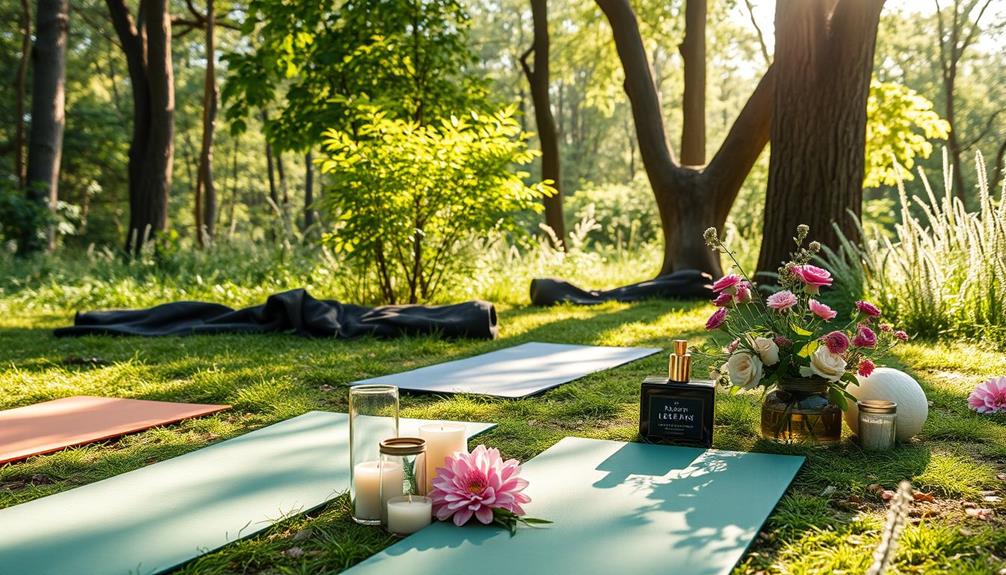
To create and market day retreat packages, start by defining clear objectives and understanding your target audience's needs. Select a comfortable venue and structure your activities with a mix of workshops and downtime. Craft a compelling value proposition that highlights unique benefits. Promote your retreat through social media, email campaigns, and influencer collaborations to reach more potential participants. Use high-quality visuals and testimonials to enhance your marketing materials. Finally, gather feedback post-retreat to improve future offerings. With these steps, you'll be well on your way to running successful day retreats. There's more to explore!
Key Takeaways
- Define clear objectives for your retreat to guide planning and communicate effectively in marketing materials.
- Understand your target audience's desires and pain points to create compelling packages that resonate with them.
- Choose a suitable venue that aligns with your retreat goals and enhances participant comfort and experience.
- Utilize social media and email campaigns to promote the unique benefits of your retreat and engage potential participants.
- Gather feedback and testimonials post-retreat to refine future offerings and enhance credibility in marketing efforts.
Understanding Day Retreats

When you think about day retreats, imagine a rejuvenating break from your daily routine that lasts just a few hours to a full day. These retreats focus on relaxation, personal development, and community building, offering a revitalizing escape without the commitment of overnight stays.
You'll find a mix of structured activities like workshops, yoga sessions, and group discussions, all designed to foster connection and growth. Incorporating elements such as heartfelt expressions of love can create a more profound impact on participants' experiences.
Understanding your target audience is essential when planning your retreat. Tailor your offerings to specific themes—be it wellness, creativity, or team-building—to guarantee you're meeting the unique needs of participants. This versatility makes day retreats appealing to a wide range of demographics, from busy professionals seeking a brief reprieve to individuals looking for personal growth experiences.
To effectively promote your retreat, consider your marketing strategies carefully. Highlight the benefits of a short, impactful experience that enhances engagement and builds relationships.
Benefits of Hosting Retreats
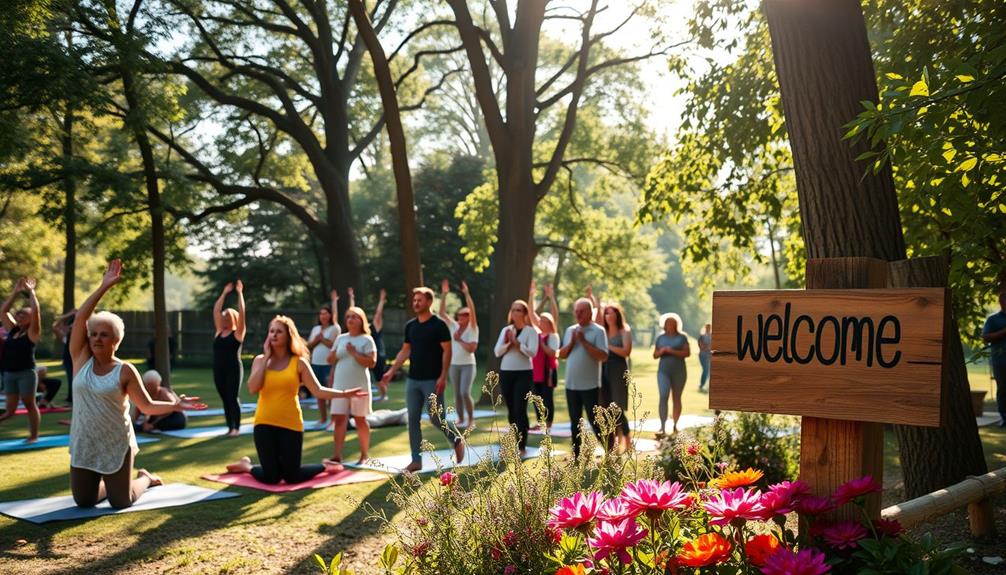
Hosting day retreats offers numerous benefits that extend beyond the immediate experience for both organizers and participants. When you engage in hosting retreats, you create an environment that fosters deeper connections with attendees, leading to increased brand loyalty and client retention. Participants often feel more valued and engaged in this unique setting.
Additionally, retreats can harness the power of imagination, enabling participants to explore transformative possibilities that enhance their personal and professional growth.
These retreats provide a dedicated space for learning and collaboration, allowing everyone to step away from their daily routines. This focused atmosphere encourages personal and professional development, boosting creativity and productivity. Attendees frequently leave with innovative ideas and solutions they mightn't have conceived in typical settings.
From a financial perspective, organizing retreats can serve as a lucrative income generator. Satisfied attendees can become repeat customers and refer others, enhancing your revenue over time.
Furthermore, wellness retreats greatly improve participant well-being, as they typically include activities centered on relaxation, reflection, and personal growth. This focus on well-being contributes to a more fulfilled and balanced life for your attendees, making your retreats not just an event but an enriching experience.
Essential Planning Tips
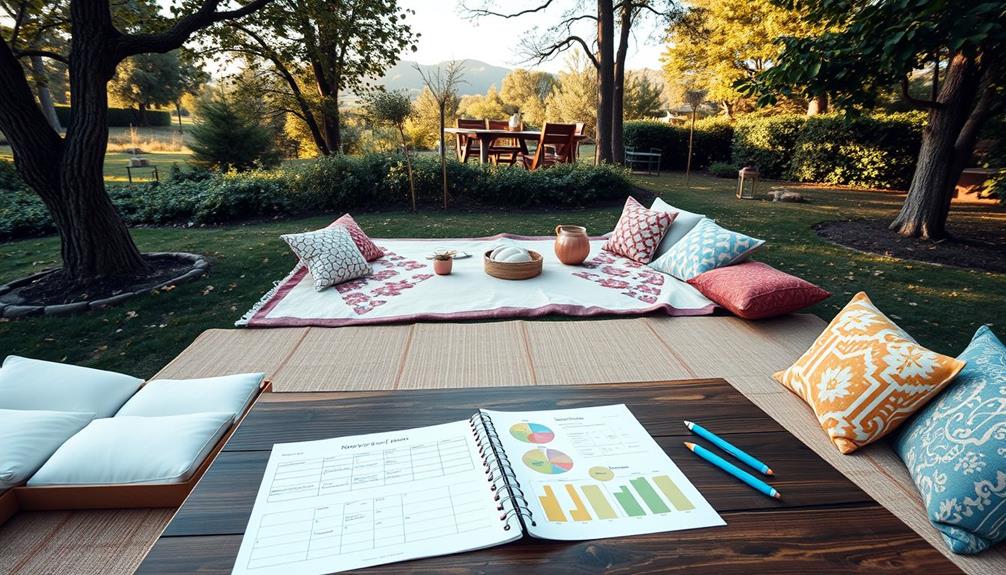
When planning your day retreat, it's essential to define your objectives clearly. This will guide every aspect of the event, from the activities you choose to the venue you select.
Incorporating elements of design thinking can enhance your planning process by ensuring that you prioritize user experience and foster collaboration among participants.
An ideal venue not only aligns with your goals but also creates a comfortable space for participants to engage and relax.
Define Objectives Clearly
Defining objectives clearly is essential for the success of your day retreat. Start by identifying the primary purpose of the retreat—whether it's relaxation, skill-building, or team-building. This focus helps guarantee that your planning aligns with your core goals.
Establish specific objectives, like the number of participants and desired outcomes for attendees. These will guide your retreat's structure and content.
Incorporating elements like the importance of astrology and attractiveness may also enhance the appeal of your retreat, making it more relatable to potential participants.
Next, align your agenda with these defined objectives. Select activities, speakers, and experiences that directly contribute to achieving your goals. This alignment not only enhances the retreat experience but also guarantees that participants find value in what you offer.
Don't forget to communicate your retreat's objectives in all your marketing materials. By doing this, you can attract the right people who resonate with your vision and set appropriate expectations for participants.
Consider incorporating feedback mechanisms during and after the retreat to assess whether your objectives were met. This approach not only enhances your current retreat but also informs future planning efforts, refining your marketing strategy and guaranteeing continued success.
Select Ideal Venue
Selecting the ideal venue for your day retreat sets the stage for a successful experience. Choose a retreat center that aligns with your theme, offering amenities that enhance relaxation and engagement. Look for natural surroundings for outdoor activities or spacious rooms for workshops to create the best user experience.
Considering the importance of financial considerations for elderly care can also inform your selection if your retreat is aimed at caregivers or seniors.
Accessibility is vital, so select a location that's easily reachable by public transport or major highways. Provide clear directions to avoid confusion among participants.
Evaluate the venue's capacity to comfortably accommodate your expected number of attendees, keeping in mind breakout sessions and communal spaces for networking.
Essential facilities like adequate parking, restrooms, and catering options will simplify logistics and enhance the overall experience. Make sure your venue can support these needs.
Additionally, assess the availability of extra services, such as technical support for audiovisual equipment or wellness offerings like massage therapy. These features can create a thorough retreat package that participants will appreciate.
Crafting Compelling Packages
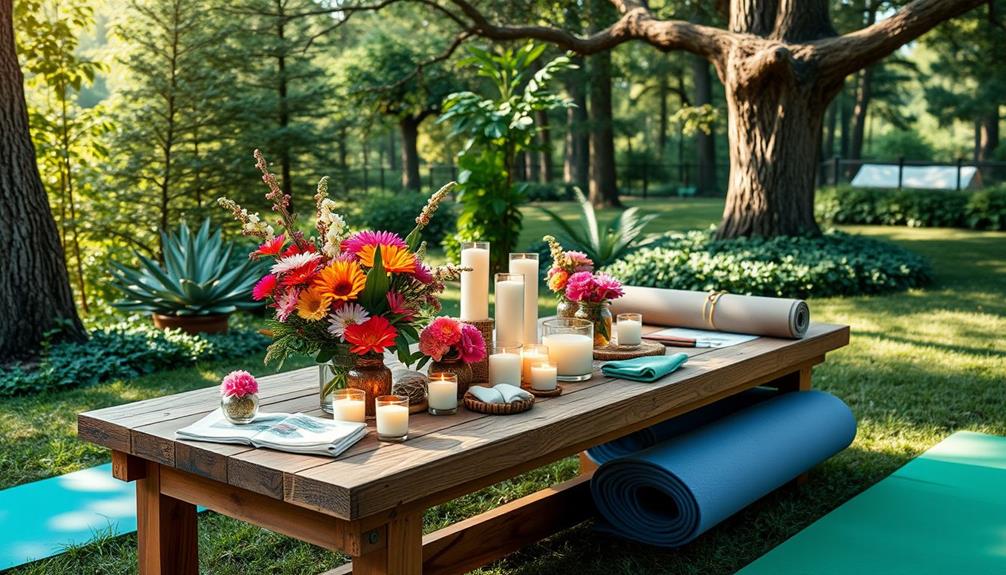
Crafting compelling packages for your day retreat requires a keen understanding of your audience's desires and challenges. Start by defining your target audience. Identify their interests, needs, and pain points to tailor offerings that truly resonate.
Consider incorporating elements that promote relaxation and wellness, such as hydrotherapy, which can enhance the therapeutic aspect of your retreat. Next, create a compelling value proposition that highlights the unique benefits of your retreat, such as stress relief, personal growth, or skill development. This will be essential in your retreat marketing efforts.
Structure your packages to include a balanced mix of activities—workshops, wellness sessions, and downtime—to guarantee participants have a fulfilling and rejuvenating experience throughout the day. Flexibility is key; consider incorporating pricing options like early-bird discounts or group rates to incentivize bookings and encourage word-of-mouth referrals among attendees.
Additionally, don't underestimate the power of visuals and testimonials in your marketing materials. High-quality images and authentic feedback from past participants can help potential customers visualize themselves at your retreat, enhancing credibility and interest.
Marketing Your Retreat Effectively
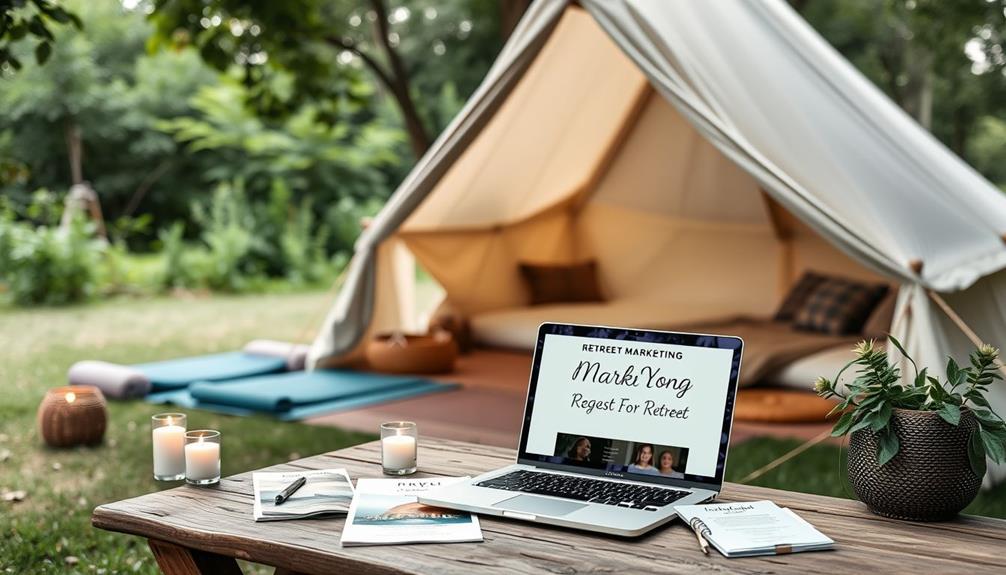
To market your retreat effectively, you first need to identify your target audience and understand their needs.
Researching best ways to earn money online can also provide insights into what potential attendees may be seeking in a retreat experience.
Once you know who you're speaking to, create compelling content that highlights the unique experiences your retreat offers.
Engaging with your audience on social media will help you build excitement and draw in potential attendees.
Target Audience Identification
Identifying your target audience is essential for effectively marketing your day retreat packages, as it allows you to tailor your messaging to resonate with potential attendees. Start by pinpointing specific demographics like age, interests, and lifestyle preferences that align with your offerings. This foundational step in target audience identification helps you refine your marketing strategies.
Additionally, consider how outdoor enthusiasts are drawn to unique experiences, such as diverse tent camping locations, which can inform your retreat themes and activities.
Conduct surveys or focus groups within your existing client base to gather insights about their needs and expectations for day retreats. This feedback can guide your offerings and make your marketing efforts more impactful.
Additionally, utilize social media analytics to discover which platforms your target audience engages with most, focusing on spaces like Instagram and Facebook.
Create compelling personas based on your ideal participants, incorporating their challenges and desires. This approach can enhance your messaging and result in more relatable promotional content.
Compelling Content Creation
Once you've pinpointed your target audience, the next step is to create compelling content that resonates with them. Start by utilizing high-quality images and videos that capture the essence of your day retreat. For inspiration, consider how creative breakfast crepes recipes can elevate a retreat's culinary offerings, showcasing activities, participant engagement, and the venue to create an appealing visual narrative. This is essential for effective content creation in your social media marketing efforts.
Next, craft blog posts or social media content that address the common challenges or desires of your audience. Position your retreat as a solution for personal growth and relaxation.
Don't forget to leverage testimonials from past participants; these build trust and credibility by highlighting transformative experiences.
To drive action, use targeted social media ads and email marketing campaigns to promote early-bird pricing or exclusive offers, enticing potential attendees to register quickly.
Social Media Engagement
Engaging on social media is essential for successfully marketing your day retreat. It's a powerful tool to help you market your offerings and connect with potential attendees. Incorporating elements like music therapy integration in your retreat can also be showcased through social media, emphasizing the emotional well-being benefits participants can experience.
Here are three effective strategies to boost your social media engagement:
- Showcase Your Retreat: Utilize visually appealing platforms like Instagram and TikTok. Share high-quality images and engaging videos that highlight unique activities and the serene environment of your retreat.
- Leverage Hashtags and Geo-tags: Use trending hashtags and geo-tags to expand your reach. This guarantees your posts are discoverable by those interested in wellness and personal development experiences, increasing your visibility.
- Encourage User-Generated Content: Ask past participants to share their experiences and tag your retreat. This not only amplifies your visibility but also builds a sense of community around your brand.
Additionally, create compelling stories or reels that capture behind-the-scenes moments and participant testimonials. Consistently engage with your audience through interactive content like polls and Q&As.
Engaging Your Audience
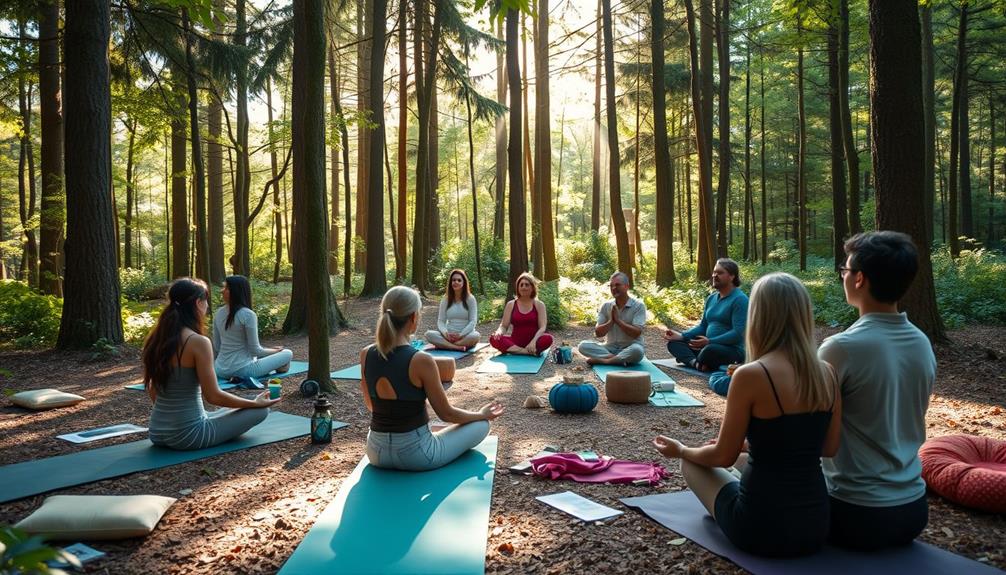
Capturing your audience's attention is essential for the success of your day retreat packages. Engaging your audience goes beyond just informing them; it's about creating a connection.
Start by showcasing stunning visuals and authentic stories from past retreats on platforms like Instagram and Facebook. These images will resonate with potential attendees and illustrate the positive impact your retreats can have on their well-being.
You also need to know that interactive content can boost involvement. Consider using polls or Q&A sessions to invite feedback on retreat themes and activities. This not only engages your audience, but it also helps you tailor your offerings to their interests.
Don't forget about targeted email marketing. Highlight unique offerings and early-bird discounts to foster a sense of urgency and exclusivity. Sharing testimonials and success stories from previous participants builds trust and credibility, demonstrating the tangible benefits of attending your retreats.
Lastly, leverage partnerships with influencers or local wellness practitioners. Their established audiences can enhance visibility for your day retreat packages, attracting more attendees and expanding your reach.
Utilizing Social Media
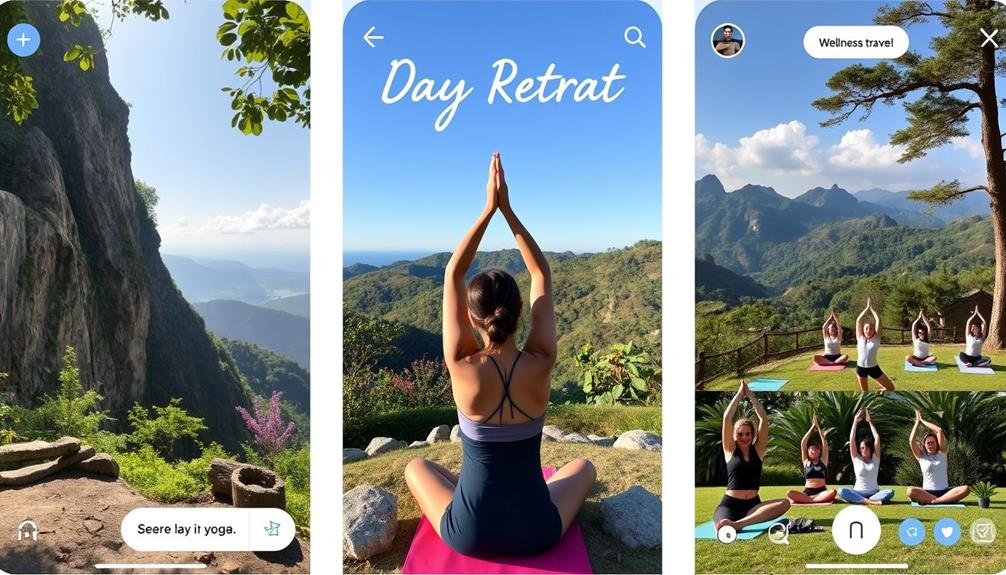
In today's digital landscape, utilizing social media is essential for promoting your day retreat packages effectively. To reach a wider audience and attract potential attendees, focus on creating engaging content that resonates with your target market.
Here are three strategies to enhance your social media presence:
- Leverage Visual Platforms: Use visually-driven platforms like Instagram and TikTok to showcase your retreat. High-quality images and engaging videos can capture attention and highlight unique aspects of your offerings.
- Use Trending Hashtags: Incorporate trending hashtags related to wellness, relaxation, and personal development in your posts. This practice boosts your visibility and connects you with individuals interested in these themes.
- Collaborate with Influencers: Partner with influencers in the wellness space to increase your exposure and credibility. Their endorsements can greatly amplify your reach and attract new clients.
Regularly update your channels with behind-the-scenes content, participant testimonials, and sneak peeks of activities.
This consistent engagement fosters excitement and builds a community around your retreat, making it more appealing to potential attendees.
Gathering Feedback and Testimonials
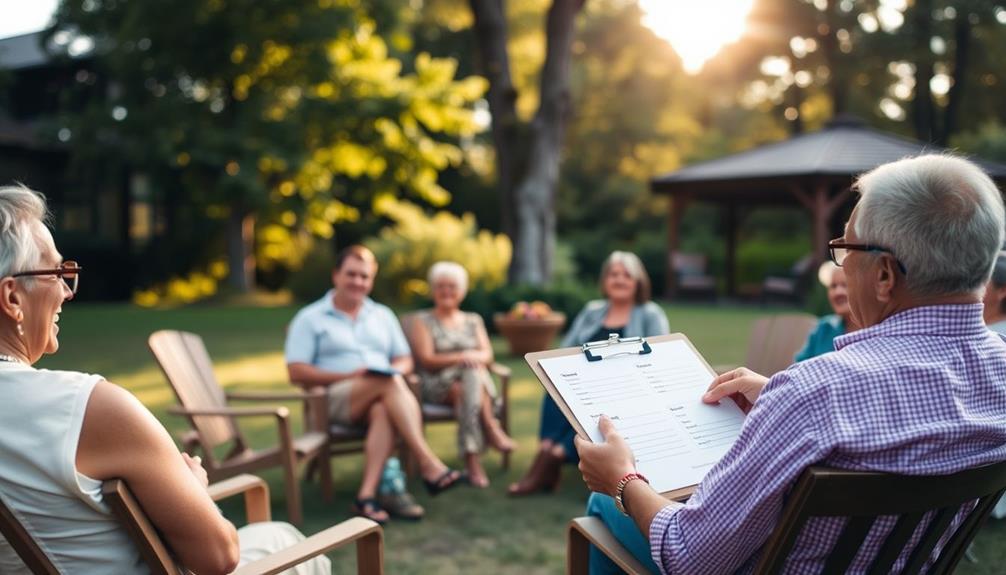
Regularly gathering feedback and testimonials is essential for enhancing your day retreat packages. Collecting feedback immediately after the retreat can provide valuable insights into participants' experiences, helping you pinpoint strengths and areas for improvement.
Use short questionnaires or surveys to facilitate this process; they encourage participants to reflect on their experiences while they're still fresh in their minds.
Don't underestimate the power of authentic testimonials in your marketing efforts. Display them prominently on your website and social media platforms to increase trust and credibility.
Potential clients are more likely to register for future retreats when they see positive reviews from previous attendees.
Pay attention to feedback from those who didn't register, too. Analyzing their objections can help you refine your offerings, ensuring they better meet the needs of your target audience.
Keep things fresh by regularly updating your marketing content with new testimonials and participant feedback. This not only attracts new clients but also boosts interest in upcoming retreats.
Frequently Asked Questions
How Do I Create a Retreat Program?
To create a retreat program, establish clear objectives, choose a fitting venue, develop a balanced agenda, incorporate engaging activities, and gather feedback afterward. This process guarantees your program meets participants' needs and enhances their experience.
How Do You Plan a Retreat Day?
Planning a retreat day is like orchestrating a symphony! Start by defining your objectives, choose a fitting venue, structure a balanced agenda, incorporate interactive elements, and gather feedback to perfect your future events.
How Do You Create a Budget for a Retreat?
To create a budget for your retreat, estimate fixed and variable costs, allocate a contingency fund, and set a pricing strategy. Regularly review your budget to guarantee you're covering expenses while maintaining profit margins.
How Do I Market My Retreat?
You've got a fantastic idea, and now it's time to share it! Use social media to showcase your retreat's unique experiences, create an enticing landing page, and connect with local influencers to expand your reach.
Conclusion
In wrapping up, launching your day retreat packages can be a game-changer for both you and your participants. By understanding your audience and crafting enticing experiences, you're not just selling a day away—you're offering a refreshing change. Remember, marketing is the spark that lights the fire of interest, so don't shy away from using social media to share your vision. With a little creativity and passion, you'll turn your dreams into reality!
- About the Author
- Latest Posts
Introducing Ron, the home decor aficionado at ByRetreat, whose passion for creating beautiful and inviting spaces is at the heart of his work. With his deep knowledge of home decor and his innate sense of style, Ron brings a wealth of expertise and a keen eye for detail to the ByRetreat team.
Ron’s love for home decor goes beyond aesthetics; he understands that our surroundings play a significant role in our overall well-being and productivity. With this in mind, Ron is dedicated to transforming remote workspaces into havens of comfort, functionality, and beauty.
-
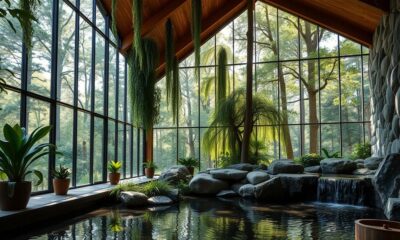
 Retreat3 weeks ago
Retreat3 weeks agoIncorporating Biophilic Design in Your Retreat Center
-

 Retreat4 weeks ago
Retreat4 weeks agoDesigning a Retreat Center Kitchen: From Layout to Equipment
-

 Southeast Asia Decor4 weeks ago
Southeast Asia Decor4 weeks agoHistorical Feng Shui Color Schemes in Interiors
-
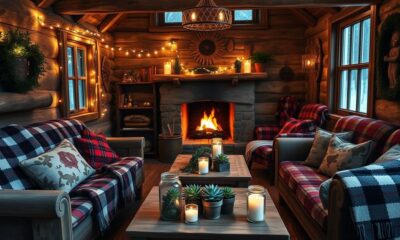
 Retreat4 weeks ago
Retreat4 weeks agoDIY Rustic Decor Ideas for a Cozy Retreat Atmosphere
-

 Southeast Asia Decor3 weeks ago
Southeast Asia Decor3 weeks agoUltimate Guide to Harmonious Furniture Placement
-

 Retreat4 weeks ago
Retreat4 weeks agoHow to Design a Multi-Purpose Space in Your Retreat Center
-

 Retreat2 weeks ago
Retreat2 weeks agoHow to Design and Build a Sweat Lodge for Your Retreat Center
-

 Southeast Asia Decor3 weeks ago
Southeast Asia Decor3 weeks agoHarmonizing Spaces: The Art of Feng Shui Design










